How Time Magazine Sacrificed Its Standards to Promote Saturated Fat
By Plant Positive
June 28, 2014
The editors of Time Magazine want you to eat butter. They said so on the cover of their June 23, 2014 issue. Why would they want you to eat butter? Butter is high in saturated fat so it raises our LDL-C[1], or “bad” cholesterol. The cholesterol in LDL particles is considered “bad” because it builds up the plaque in our arteries. Saturated fats also seem to promote inflammation[2]. Why would Time promote butter and other foods high in saturated fat? What was their argument to eat this way?
The Time piece was written by Bryan Walsh and for the most part it was predictable rehash of the many myths and fallacies embraced by low-carbohydrate diet advocates for decades now. I’ve created a website and a YouTube channel to educate the public about the tricks of the low-carb promoters and this article offered nothing I haven’t seen already. What sets this article apart, however, was its prominence. Somehow the low-carb world’s distorted view of nutrition found its way into the pages of the nation’s leading news magazine.  While this should be distressing to anyone who cares about public health, this failure of judgment by Time’s editors does create an opportunity to right a wrong. Perhaps now we can finally dispatch a particularly dishonest narrative pushed by the low-carbers, one they have circulated for years.
While this should be distressing to anyone who cares about public health, this failure of judgment by Time’s editors does create an opportunity to right a wrong. Perhaps now we can finally dispatch a particularly dishonest narrative pushed by the low-carbers, one they have circulated for years.
That narrative is an attack on the integrity of Ancel Keys. Keys was one of the most important contributors to the war against heart disease of the last century. Rather than celebrate his career, the low-carbers have ridiculed him relentlessly, especially since his passing in 2004. Walsh has joined this attack with his Time article. But despite all the critiques of Keys that have preceded his Time piece, Walsh doesn’t seem to understand what’s supposed to have been wrong with Keys’ work. As I’ve shown my viewers, Keys’ detractors often become confused about what papers of his they don’t like and what those papers were about. As you’ll see, Walsh seems to be confused as well. This confusion of his makes responding to him a little tricky but I’ll give it a try.
Would someone please explain to Bryan Walsh what cherry picking is?
“Keys' work became the foundation for a body of science implicating fat as a major risk factor for heart disease. The Seven Countries Study has been referenced close to 1 million times. But Keys' research had problems from the start. He cherry-picked his data.... Keys highlighted the Greek island of Crete… ‘It was highly flawed,’ says Dr. Peter Attia, the president and director of the Nutrition Science Initiative, an independent obesity-research center. ‘It was not on the level of epidemiology work today.’" – Bryan Walsh
Keys is often accused of cherry picking. It’s a false charge but let’s not get into that just yet. The first problem with this quotation is that Walsh doesn’t seem to understand what data Keys is supposed to have cherry picked. Walsh is here clearly referring to Keys’ pioneering epidemiological study commonly called the Seven Countries Study[3], in which Keys collaborated with other researchers in a project spanning locales in seven different countries. The researchers followed a group of men in each of 16 communities over a period of years, taking note of their diets, cholesterol levels, blood pressure, weight, etc. with an eye toward seeing which of their traits correlated with coronary heart disease. This study was what we today call a “prospective cohort study.” Keys didn’t throw out the data from any of his cohorts. He published the results from all of them. Therefore, by definition, he could not have cherry picked data. Walsh’s charge makes no sense.
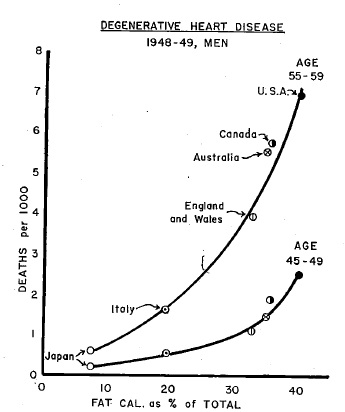 Let’s now pretend that Walsh understood and was able to express the common cherry picking claim against Keys. It’s likely he meant that Keys cherry picked in a 1953[4] paper which compared fat consumption with deaths from coronary disease, producing the scatter plot to the right. Four years later this paper was criticized by two other researchers who argued that Keys incorrectly excluded data from other countries to create that graph. You can see Keys compared total fat intake to coronary deaths in six countries. Data for at least 22 countries were available to him so why did he choose only these six?
Let’s now pretend that Walsh understood and was able to express the common cherry picking claim against Keys. It’s likely he meant that Keys cherry picked in a 1953[4] paper which compared fat consumption with deaths from coronary disease, producing the scatter plot to the right. Four years later this paper was criticized by two other researchers who argued that Keys incorrectly excluded data from other countries to create that graph. You can see Keys compared total fat intake to coronary deaths in six countries. Data for at least 22 countries were available to him so why did he choose only these six?
Did Keys cherry pick in that earlier paper?
“Keys' unshakable confidence and his willingness to take down any researcher who disagreed with him was at least as important as his massive data sets. (When the biostatistician Jacob Yerushalmy published a 1957 paper questioning the causal relationship between fat and heart disease, Keys responded sharply in print, claiming that Yerushalmy's data was badly flawed.)” – Bryan Walsh
I’m not sure why but Walsh has left out the name of Jacob Yerushalmy’s co-author for that 1957 paper[5], Herman Hilleboe. He also excluded a rather interesting piece of information.  Yerushalmy and Hilleboe found animal protein to correlate better with heart disease deaths than fat, better than any other factor in the diet, as you can see in this scan of their paper. But you’d never know that from Walsh’s article. He also left out the fact that two other researchers, Norman Joliffe and Morton Archer[6], scrutinized Yerushalmy and Hilleboe’s critique two years later and found them to have inexplicably ignored the crucial distinction between saturated fats, which raise cholesterol, and unsaturated fats, which don’t. See for yourself:
Yerushalmy and Hilleboe found animal protein to correlate better with heart disease deaths than fat, better than any other factor in the diet, as you can see in this scan of their paper. But you’d never know that from Walsh’s article. He also left out the fact that two other researchers, Norman Joliffe and Morton Archer[6], scrutinized Yerushalmy and Hilleboe’s critique two years later and found them to have inexplicably ignored the crucial distinction between saturated fats, which raise cholesterol, and unsaturated fats, which don’t. See for yourself:
So what meaning did Joliffe and Archer find in their analysis of the same data? They said that “the intake of saturated types of fat was most important in accounting for the differences in coronary heart disease death rates.” Animal protein came in second place. 
Now ask yourself, if it was wrong for Yerushalmy and Hilleboe to have ignored the difference between saturated and unsaturated fat in 1957, how much worse is it for a journalist to ignore that difference in 2014?
Yerushalmy and Hilleboe weren’t the first to argue that the statistics from some nations made it hard to blame fats for coronary deaths. This argument was apparently first made by the National Dairy Council[7], who didn’t like the suggestion that the fats they marketed could be blamed for heart disease. They said that the lower death rates from heart disease in the Netherlands, for example, where dairy fats were consumed in greater quantity, argued against Keys’ scatter plot.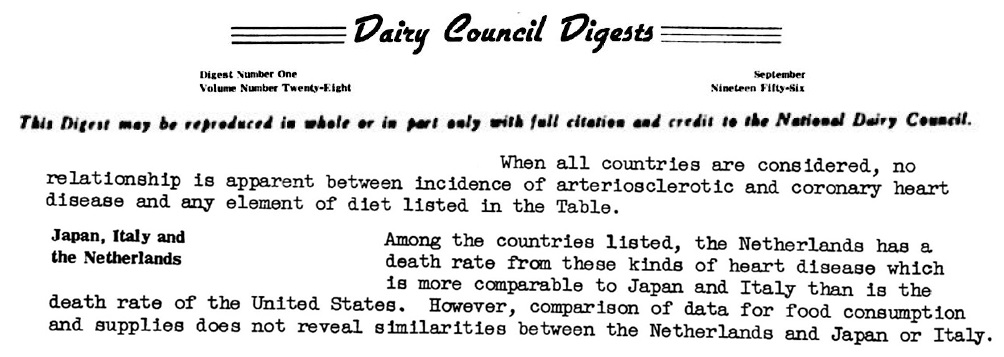
This, however, was an inappropriate comparison. It takes many years to develop heart disease. Most of us have to eat a lot of greasy foods over a long time to die from that habit. 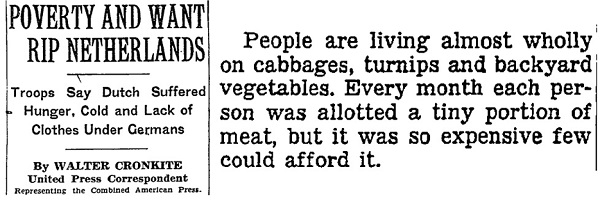 The conditions that would have enabled this dietary practice would have been highly unlikely in the Netherlands in those days. All that mortality data came from the 1950s, which happened to be preceded by World War II, when many populations suffered serious privation, including the Dutch. Walter Cronkite told America[8] that they lived “almost wholly on cabbages, turnips, and backyard vegetables” during the war. Cronkite didn’t mention finding an abundant supply of high-fat dairy products amid all that “poverty and want.” The National Dairy Council should have known better. Other countries had unsuitable data as well. Mexico wasn’t able to certify the deaths of large segments of their population. These are but two examples. I’ve discussed others in my videos about Keys’ supposed cherry picking. As he explained in 1953 when he created the plot, he could only include those countries with "fully comparable" data.
The conditions that would have enabled this dietary practice would have been highly unlikely in the Netherlands in those days. All that mortality data came from the 1950s, which happened to be preceded by World War II, when many populations suffered serious privation, including the Dutch. Walter Cronkite told America[8] that they lived “almost wholly on cabbages, turnips, and backyard vegetables” during the war. Cronkite didn’t mention finding an abundant supply of high-fat dairy products amid all that “poverty and want.” The National Dairy Council should have known better. Other countries had unsuitable data as well. Mexico wasn’t able to certify the deaths of large segments of their population. These are but two examples. I’ve discussed others in my videos about Keys’ supposed cherry picking. As he explained in 1953 when he created the plot, he could only include those countries with "fully comparable" data.
Recall from his quote that Walsh was trying to fault Keys for leaving out France and West Germany from that 1953 paper.  But why should Keys have included them? France was known to have different practices in categorizing deaths from diseases of the heart, making their statistics unusable, as Ruth Puffer and Louis Verhoestraete noted here[9].
But why should Keys have included them? France was known to have different practices in categorizing deaths from diseases of the heart, making their statistics unusable, as Ruth Puffer and Louis Verhoestraete noted here[9].
Keys ably defended himself against Yerushalmy and Hilleboe’s arguments in 1957[10]. If Walsh had bothered to visit a library while researching his article he could have learned why Keys ignored the data from West Germany. As Keys explained, the diets of the Germans had been affected by the war, and their population had been highly unstable during that period, making them a poor choice for inclusion in his graph. Keys wrote:
 “I have mentioned West Germany where the diet changed little during the war years but where the fat intake was very low for several years after the war. A further complication is the tremendous migration into this country since the war. A population of 40 million has taken in about 11 million refugees and escapees from the East. The immigrants, as is always the case, are not a good sample in regard to age, vigor, and state of health of the population from which they migrated. And in the case of West Germany the majority of the immigrants left behind them a diet very different from that of their new land of settlement.” – Ancel Keys
“I have mentioned West Germany where the diet changed little during the war years but where the fat intake was very low for several years after the war. A further complication is the tremendous migration into this country since the war. A population of 40 million has taken in about 11 million refugees and escapees from the East. The immigrants, as is always the case, are not a good sample in regard to age, vigor, and state of health of the population from which they migrated. And in the case of West Germany the majority of the immigrants left behind them a diet very different from that of their new land of settlement.” – Ancel Keys
In the same editorial, written to respond to the criticisms of Yerushalmy and Hilleboe, Keys also commented on the inconsistencies between countries with regard to their classifications of cause of death, as discussed above.

Keys also indicated that he understood he should have been comparing death rates with saturated fat intake, not total fat intake, back in 1953. He said, “Such epidemiologic suggestions as there are for an effect of animal protein are readily accounted for by the high correlation between animal protein and animal fat intakes in most human populations.”
So you see, Walsh was wrong about what Keys was supposed to have cherry picked, and the cherry picking charge is false anyway, and a more thorough investigation of these cherry picking claims actually argues against saturated fat consumption. Walsh seems to have had this story wrong in every way possible.
What about the Seven Countries Study?
Now let’s consider Walsh’s argument against the Seven Countries Study itself. He thinks a comparison between the cohorts in Corfu and Crete blows up the correlation Keys found between saturated fat consumption and coronary death. He wrote:
“Keys highlighted the Greek island of Crete, where almost no cheese or meat was eaten and people lived to an old age with clear arteries. But Keys visited Crete in the years following World War II, when the island was still recovering from German occupation and the diet was artificially lean. Even more confusing, Greeks on the neighboring isle of Corfu ate far less saturated fat than Cretans yet had much higher rates of heart disease.” – Bryan Walsh
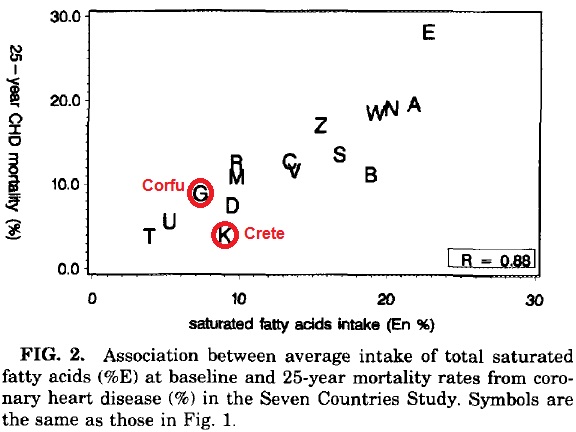 The Seven Countries Study began in 1958*, well after World War II, so his first point about when Keys visited there is irrelevant. The study’s results were first published in 1970 but the study itself didn’t end then. Here’s a comparison[11] between its different cohorts showing saturated fat intake along the horizontal axis and coronary mortality at 25 years along the vertical axis. Corfu and Crete are highlighted. You can see that Walsh is excluding an awful lot of information when he limits his focus to these two places. Ignoring those other cohorts would be a form of cherry picking.
The Seven Countries Study began in 1958*, well after World War II, so his first point about when Keys visited there is irrelevant. The study’s results were first published in 1970 but the study itself didn’t end then. Here’s a comparison[11] between its different cohorts showing saturated fat intake along the horizontal axis and coronary mortality at 25 years along the vertical axis. Corfu and Crete are highlighted. You can see that Walsh is excluding an awful lot of information when he limits his focus to these two places. Ignoring those other cohorts would be a form of cherry picking.
Why should Corfu and Crete have had such different outcomes? A better question might be, why assume that the only relevant difference between them was their saturated fat consumption? Saturated fat isn’t all that matters in the diet. The people in Corfu consumed much more alcohol than the Cretans[12]. High levels of alcohol consumption increase the risk of heart disease.
You can learn more about the Seven Countries Study here. You can also learn much more about Ancel Keys and the false charges against him at my website. I’ve been correcting the low-carb story about him since 2011.
What about the rest of his article?
There was a lot wrong with Walsh’s article, too much for me to properly address now (I’m not collecting a paycheck from Time or anyone else to write this). But I can give you a sense of what was wrong with the rest of his article. Walsh referred to another study. He wrote, “A 2010 meta-analysis – basically a study of other studies – concluded that there was no significant evidence that saturated fat is associated with an increased risk of cardiovascular disease.” I’ve addressed this meta-analysis at length already. It turns out when you look at the individual studies being studied in that meta-analysis, for the most part they make saturated fat look quite guilty of causing coronary deaths. Walsh related that meta-analysis to a more recent one when he wrote, “Those results were echoed by another meta-analysis published in March in the Annals of Internal Medicine that drew on nearly 80 studies involving more than half a million subjects.” I’ve written about this one as well. What sense would it make to include studies in a review of the effects of saturated fat in which every participant was taking cholesterol lowering medications? Remember, saturated fat increases the risk of heart disease by raising our cholesterol levels. But that’s exactly what the authors of that second meta-analysis did.
Walsh solicited most of the comments from experts in his article from fringe doctors who profit by promoting low-carbohydrate diets. For example, he quoted Eric Westman, Jeff Volek, and Stephen Phinney. All of them have received money from the Atkins Foundation, named for low-carber Robert Atkins, and they’re all authors of a recent book promoting Atkins.
To discover the influence of special interests in low-carb research, you sometimes have to do some sleuthing. Take the case of Jeff Volek, for example. He is working on a paper meant to “demonstrate that plasma saturated fat levels are a function of dietary carbohydrate intake rather than saturated fat intake, which would help neutralize the negative image of beef, dairy and eggs (all naturally low carbohydrate foods) by showing their intake per se is associated with favorable metabolic health effects.”  This quote comes from a document from the beef industry[13] in which they give an accounting of their marketing efforts. They list their “subcontractor” on this promotional study, its outcome already anticipated, as the University of Connecticut, where Volek works.
This quote comes from a document from the beef industry[13] in which they give an accounting of their marketing efforts. They list their “subcontractor” on this promotional study, its outcome already anticipated, as the University of Connecticut, where Volek works.
But the beef industry isn’t the only purveyor of the fats that slowly kill us who is paying for Volek’s institution to produce research that is supposed to convince us otherwise. The egg industry is financing this study as well. This is the normal behavior of the animal food lobby.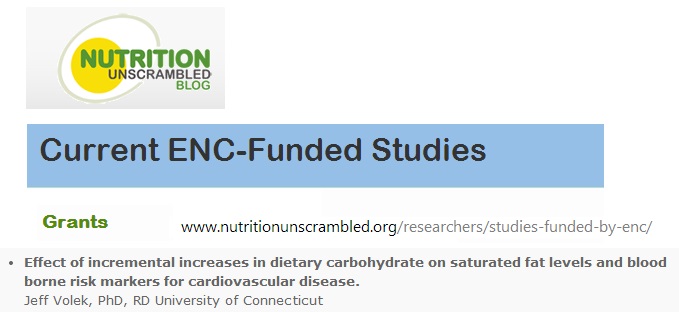
Ronald Krauss is also quoted in the article. He’s one of the co-authors of that 2010 meta-analysis, and he’s also taken money from the Atkins Foundation and others in the animal food lobby. Krauss is Walsh’s reference for the now discredited claim that some LDL particles can cause heart disease while others can’t. But his judgment on that subject might be slightly influenced by the fact that he holds a patent, the value of which is riding on the acceptance of this notion.
Walsh also quotes Peter Attia, a low-carb promoter looking for donations along with Gary Taubes so they can promote low carb diets through the “obesity-research center” mentioned above. You can see him here wearing a "Praise the Lard" t-shirt. I’ve made several videos about Attia and Taubes which reveal their obvious biases. David Ludwig, also named in the article, is working for them now.
But you didn’t need me to tell you all that for you to know that Walsh’s piece was almost entirely propaganda. In both his article and the accompanying video on the Time website, he only refers to “carbs” as a single entity, with nary a distinction to be made between the different types of carbs. Go ahead and try to find the phrase “whole grains” in either piece. You won’t be able to do it. This is a very basic omission. Everyone in nutrition knows there is a big difference between a sugary soda and a Russet potato. Why do you think Walsh failed to mention this?
How did this story get published in Time?
High cholesterol is a serious problem. Heart disease is our number one killer in America. A large fraction of our children now have high cholesterol. Why would Time want to make this problem worse?
Bill Maher, commenting on this edition of Time, answered this question by stating the obvious.
“They’re having such a hard time, and this is why they put out covers like this. Because they have to tell people, to try to sell a few goddamn copies, they have to tell people what they want to hear: Eat Butter!” – Bill Maher[14]
Time, Inc.’s profits have been suffering and they’ve been laying off staff. Apparently, they’ll even sacrifice their reputation for journalistic integrity for some short term positive cash flow. Time’s managing editor Nancy Gibbs should be the last person to let a story this biased and riddled with errors reach readers. She began her career at Time as a fact checker. Let’s hope my fact checking of this article helps her realize that America doesn’t need a Time magazine if its writers can’t produce better work than the typical low carb blog.
For more please find this related article I wrote for Dr. John McDougall’s newsletter.
* Date corrected 7/1/2014.
[1] Nestel, P. J., A. Chronopulos, and M. Cehun. "Dairy fat in cheese raises LDL cholesterol less than that in butter in mildly hypercholesterolaemic subjects."European journal of clinical nutrition 59, no. 9 (2005): 1059-1063.
[2] van Dijk, Susan J., Edith JM Feskens, Marieke B. Bos, Dianne WM Hoelen, Rik Heijligenberg, Mechteld Grootte Bromhaar, Lisette CPGM de Groot, Jeanne HM de Vries, Michael Müller, and Lydia A. Afman. "A saturated fatty acid–rich diet induces an obesity-linked proinflammatory gene expression profile in adipose tissue of subjects at risk of metabolic syndrome." The American journal of clinical nutrition 90, no. 6 (2009): 1656-1664.
[3] Keys, Ancel. "Coronary heart disease in seven countries." Circulation 41, no. 1 (1970): 186-195.
[4] Keys, Ancel. “Atherosclerosis: a problem in newer public health.” J Mt Sinai Hosp N Y. 1953 Jul-Aug;20(2):118-39.
[5] Yerushalmy, Jacob, and Herman E. Hilleboe. "Fat in the diet and mortality from heart disease; a methodologic note." New York state journal of medicine 57, no. 14 (1957): 2343-2354.
[6] Jolliffe, Norman, and Morton Archer. "Statistical associations between international coronary heart disease death rates and certain environmental factors." Journal of chronic diseases 9, no. 6 (1959): 636-652.
[7] “National Food Supplies and Vital Statistics”. Dairy Council Digests. Vol. 28, No. 1. (September 1956).
[8] Cronkite, Walter. "Poverty and Want Rip Netherlands." The New York Times 29 Sept. 1944: 4. ProQuest Historical Newspapers.
[9] Puffer, Ruth R., and Louis J. Verhoestraete. "Mortality from cardiovascular diseases in various countries, with special reference to atherosclerotic heart disease: A preliminary analysis." Bulletin of the World Health Organization 19, no. 2 (1958): 315.
[10] Keys, Ancel. "Epidemiologic aspects of coronary artery disease." Journal of chronic diseases 6, no. 4 (1957): 552-559.
[11] Kromhout, Daan, Alessandro Menotti, Bennie Bloemberg, Christ Aravanis, Henry Blackburn, Ratko Buzina, Anastasios S. Dontas et al. "Dietary saturated and transfatty acids and cholesterol and 25-year mortality from coronary heart disease: the seven countries study." Preventive medicine 24, no. 3 (1995): 308-315.
[12] Kromhout, Daan, Ancel Keys, Christ Aravanis, Ratko Buzina, Flaminio Fidanza, Simona Giampaoli, Annemarie Jansen, Alessandro Menotti, Srecko Nedeljkovic, and Maija Pekkarinen. "Food consumption patterns in the 1960s in seven countries." The American journal of clinical nutrition 49, no. 5 (1989): 889-894.
[13] 2013 Evaluation of Beef Checkoff Programs, A report from the Joint Evaluation Advisory Committee. Cattlemen’s Beef Promotion and Research Board. Centennial, CO. 2013.
[14] Bill Maher. Real Time. Episode 322 (20 June 2014). HBO.